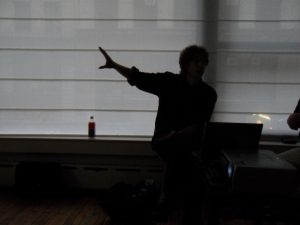 Tomorrow evening, (Wed, the 27th), I am thrilled to be doing a workshop with the Music & Music Ed Program at Teachers College.
Tomorrow evening, (Wed, the 27th), I am thrilled to be doing a workshop with the Music & Music Ed Program at Teachers College.
When work with a new group of people, the beginning is always particularly interesting. “So, what are we about to do?” is a hard enough question, but presupposes that we have already gotten past the, “Why would I want to come?” stage. Teaching in-service teachers in Education, I came to rely on the ready supply of a captive audience. We could take our time figuring out how to move from our external motivations to intrinsic ones. And, paradoxically, over the course of a semester it is amazing the ground you can cover if you take your time and don’t jump to conclusions.
So what do you do when you have two hours? Well then I would say, you slow down even more. Take your time. The biggest changes can emerge from not trying to change anything. The challenge is to hold out the possibility, like a hologram, that this two hours is a life. And that there is every reason to believe that it is up for grabs in the moment.
Great, so… uhm,… “What do you do?!”
The honest answer is, whatever comes next. But that is often not so reassuring. It is easier to be able to say what the method is. Fortunately, I have a ready answer for that: I draw on something called the Feldenkrais Method. “Great! Uhm, so Felden-what?” Since few people have heard of it, it is sort of a non-answer. Which can be both frustrating and perfect at the same time. It challenges us to figure out together, the best way to proceed.
In a too neat nutshell, we could say that the Feldenkrais Method is a kind of movement education. If it weren’t for the fact that the tends to evoke images of “movements” as a kind of repertoire. (As you might see in dance, or yoga.) If someone has heard of the equally obscure “Alexander Technique” (which is at least more common in the arts), then one could point to the similarities and differences.
Both understand our physical organization to be an emergent possibility that underlies all of our endeavors, and can be accessed through attention. Alexander does this through holding an ideal of efficient posture, and learning to recognize and inhibit all of those things we do that get in the way of its full expression. Feldenkrais starts from movement, or “acture” and brings our attention to the ways in which we can vary our experiences and learn a more complete sense of our functional possibilities.
Watching a baby make sense of its movements, for us adults, can look something like a random void. We pick out the milestones: the first time they roll over, come to sitting, crawl, walk… We tend to not know what to make of the rest, of the process. But if you attend carefully, you can see that there is a kind of natural method to the madness. Without “endgaming” an infant will continue to find itself in circumstances that are both consistent and varied, will develop strategies and hypotheses, putting their attention to full use. And there is a kind of madness to the method, in turn. They will surprise themselves, and laugh or cry. They may want a ball just out of their reach, but they will also not presuppose a concept like “crawling.” Each one of us learns to find our own way, with our own unique context, a bit of madness.
Somewhere, later on down the line, we begin to settle into something that tends to codify into a sense of who we are, and how we do things. We adjust to the way the world is, the chairs we sit in, the work we do. And there can be a distinct pleasure in that, assuming it has a kind of functionality. Even our ways of changing, or dreaming of change, settle in.
Until it doesn’t work any longer, or until we begin to get an inkling of a new question. Until, perhaps, you have two hours on a Wednesday night to play with something that has yet to be.
If that is not a provocation, I do not know what is. So free up your schedule, and I hope to see you there!
